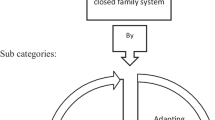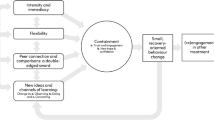Abstract
This article highlights the need for clinicians who work with eating disorders and body image problems to address the deeper family issues underlying these symptoms. The authors propose an eclectic approach including family systems, structural and experiential family therapy theory as a guide. The paper begins with an overview of family therapy theories currently used in the treatment of eating disorders, and goes into greater detail about the three theories highlighted in the eclectic model proposed. The authors present two cases with actual case dialogue, demonstrating how they used this composite model. This article has both theoretical and practical implications for clinicians working in the field.
Similar content being viewed by others
References
Barth, F. D. (2003). Separate but not alone: Separation-individuation issues in college students with eating disorders. Clinical Social Work Journal, 31(2), 139–153.
Bowen, M. (1978). Family therapy in clinical practice. New York: J. Aronson.
Campbell, T. L., & Patterson, J. M. (1995). The effectiveness of family interventions in the treatment of physical illness. Journal of Marital and Family Therapy, 21(4), 545–583. doi:10.1111/j.1752-0606.1995.tb00178.x.
Dare, C., & Eisler, I. (2002). Family therapy and eating disorders. In C. G. Fairburn & K. D. Brownell (Eds.), Eating disorders and obesity: A comprehensive handbook (pp. 314–319). New York: Guilford Press.
Diamond, G. S., Diamond, G. M., & Levy, S. A. (2014). Attachment-based family therapy for depressed adolescents. doi:10.1037/14296-000.
Eddy, K. T., Doyle, A. C., Hoste, R. R., Herzog, D. B., & Le Grange, D. (2008). Eating disorder not otherwise specified in adolescents. Journal of the American Academy of Child and Adolescent Psychiatry, 47(2), 156–164.
Fairburn, C. G. (2005). Evidence-based treatment of anorexia nervosa. International Journal of Eating Disorders. doi:10.1002/eat.20112.
Greenberg, L. S., & Johnson, S. M. (1988). Emotionally focused therapy for couples. New York: Guilford Press.
Greenman, P. S., & Johnson, S. M. (2013). Process research on emotionally focused therapy (EFT) for couples: Linking theory to practice. Family Process, 52(1), 46–61.
Greif, G. L., & Drechsler, M. (1993). Common issues for parents in a methadone maintenance group. Journal of Substance Abuse Treatment, 10(4), 339–343. doi:10.1016/0740-5472(93)90018-w.
Gurman, A. S., & Kniskern, D. P. (Eds.). (2014). Handbook of family therapy. London: Routledge.
Hare-Mustin, R. T. (1988). Family change and gender differences: Implications for theory and practice. Family Relations, 37, 36–41.
Johnson, S. M., & Johnson, S. M. (2004). The practice of emotionally focused couple therapy: Creating connection. New York: Brunner-Routledge.
Jones, W. (2010). Sett ing the stage for change: In-home family based treatment. Center for Family Based Training.
Larcher, V. (2005). ABC of adolescence: Consent, competence, and confidentiality. BMJ. British Medical Journal, 330(7487), 353.
Lock, J. (2002). Treating adolescents with eating disorders in the family context: Empirical and theoretical considerations. Child and adolescent psychiatric clinics of North America, 11(2), 331–342.
Lock, J. (2011). Evaluation of family treatment models for eating disorders. Current Opinion in Psychiatry, 24(4), 274–279. doi:10.1097/yco.0b013e328346f71e.
Lock, J., & Le Grange, D. (2015). Treatment manual for anorexia nervosa: A family-based approach. New York: Guilford.
Lock, J., Le Grange, L., & Crosby, R. (2008). Exploring possible mechanisms of change in family-based treatment for adolescent bulimia nervosa. Journal of Family Therapy, 30(3), 260–271. doi:10.1111/j.1467-6427.2008.00430.x.
Luepnitz, D. A. (1988). The family interpreted: Feminist theory in clinical practice. New York: Basic Books.
Lyons-Ruth, K. (2003). Dissociation and the parent–infant dialogue: A longitudinal perspective from attachment research. Journal of the American Psychoanalytic Association, 51(3), 883–911.
McGoldrick, M., & Carter, B. (1999). Self in context: The individual life cycle in systemic perspective. The expanded family life cycle: Individual, family and social perspectives, 3, 27–46.
McGoldrick, M., Gerson, R., Shellenberger, S., & McGoldrick, M. (1999). Genograms: Assessment and intervention. New York: W.W. Norton.
Minuchin, S., & Fishman, H. C. (2009). Family therapy techniques. Cambridge, MA: Harvard University Press.
Minuchin, S., Rosman, B. L., & Baker, L. (1978). Psychosomatic families: Anorexia nervosa in context. Cambridge, MA: Harvard University Press.
Nichols, M. P. (2008). Family therapy: Concepts and methods. Boston, MA: Pearson/Allyn and Bacon.
Nichols, M. P., & Schwartz, R. C. (2005). The essentials of family therapy. Boston, MA: Pearson/Allyn and Bacon.
Siegel, M., Brisman, J., & Weinshel, M. (2009). Surviving an eating disorder: Strategies for families and friends. New York, NY: Collins Living.
Szapocznik, J., Rio, A., Murray, E., Cohen, R., & Al, E. (1989). Structural family versus psychodynamic child therapy for problematic Hispanic boys. Journal of Consulting and Clinical Psychology, 57(5), 571–578. doi:10.1037//0022-006x.57.5.571.
Treasure, J., Smith, G., & Crane, A. (2007). Skills-based learning for caring for a loved one with an eating disorder: The new Maudsley method. London: Routledge.
Author information
Authors and Affiliations
Corresponding author
Rights and permissions
About this article
Cite this article
Gerstein, F., Pollack, F. Two Case Studies on Family Work with Eating Disorders and Body Image Issues. Clin Soc Work J 44, 69–77 (2016). https://doi.org/10.1007/s10615-015-0566-x
Published:
Issue Date:
DOI: https://doi.org/10.1007/s10615-015-0566-x




